I had never heard of Pateshwar until I read Milind Gunaji’s book Offbeat Tracks in Maharashtra sometime in 2009. I added this one in my wish list of places to be visited. As it often happens, we tend to give less importance to the nearby interesting places under the mistaken notion that they are so close that we could visit any time and most often, that time does not come. I have been living in Mumbai since 1951 but I visited the famous Babulnath temple in south Mumbai for the first time only in May 2009 whereas I visited Himlayan shrines of Badrinath and Kedarnath umpteen times.
Pateshwar is located 14 kms from Satara. After reaching Degaon village via the MIDC road, a 4 kms drive of which 2 kms are through a narrow ghat road takes to the road head one km before Pateshwar. From here, one has to walk to reach Pateshwar temple complex. The temple complex is revered by the people of Satara and its adjoining villages. But they visits this place only during Shivratri and Mondays of the Hindu month of Shravan. Rest of the year, the place is almost deserted except for the priest and two other persons who stay in the Mutt throughout the year.
 |
| On way to Pateshwar |
Last year, I and my friend Srinivasan had visited Satara to see Kaas Plateau of Flowers, Thosegar, Sajjangad and Bamnoli but could not fit in Pateshwar in our tight schedule. This year, I decided to make a revisit to Satara to see once again the Kaas Plateau of Flowers, Bamnoli, Sajjangad, Thosegar falls and Chalkewadi, with my wife who had not seen these places. Somewhere on our way to Kaas, we decided to drop Thosegar falls and Chalkewadi in favour of Pateshwar. I am not a very religious kind of a person but over a period of time, I have started believing that some of the shrines can be visited only after getting a divine call. The same driver of our hired Indica car who was not very receptive to our idea of visiting Pateshwar last year, was more than willing to take us to Pateshwar this time. So we seem to have got a divine call to visit Pateshwar this time.
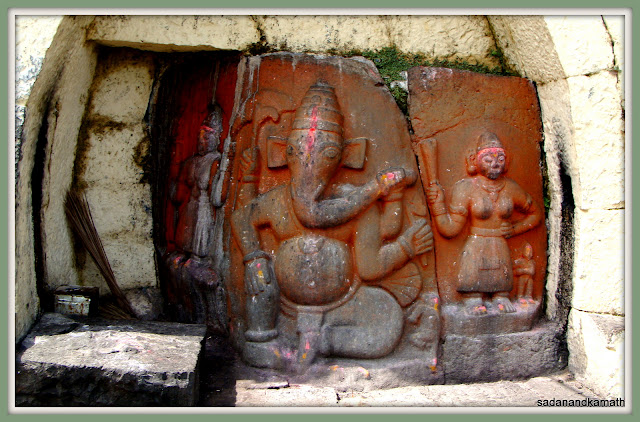 |
| Statue of Ganesh accompanied by Riddhi-Siddhi, his wives just after the start of the walk. |
 |
| View from the ridge on way to Pateshwar. |
We started for Pateshwar early morning from Radhika Hotel, Satara and after crossing NH4 via sub-way, we took the MIDC road to reach Degaon village. From here, it was 4 kms of drive on a narrow road of which 2 kms was the ghat road to reach a point where the road ended. Our driver had earlier told us that he had taken a couple from Mumbai to Pateshwar a week back but after walking a few steps, they felt that it was too secluded for their comfort. They were afraid that, being a dense forest, some wild animal may pounce on them. So they turned back despite the assurance from our driver that the place was safe and there were no cases of wild animal attacking the visitors. With this background, we commenced our walk initially on a straight path. The moment we walked past the first curve, we felt that we were really in wilderness with no one around us except some butterflies and a couple of exotic birds making frequent sorties.
 |
| Wildflowers - Malabar Delphinium on way to Pateshwar |
 |
| Wildflower - Vegna vekcilata on way to Pateshwar |
After climbing stairways made of rocks, we reached the ridge. Halfway on the stairways, there was a small temple of Lord Ganesh accompanied by Riddhi and Siddhi, his wives. Once on the ridge, the path became once again straight. From the ridge we got a beautiful valley view of MIDC on the one side and rural Satara on the other side. After about 100m walks, the path entered the dense forest mostly of teakwood and banyan trees giving us a welcome relief from the strong sun. It was a pleasant surprise for us to come across a variety of wildflowers on either side of the path. The most prominent on the valley side was a line of Malabar delphinium – a purple coloured wildflower. My wife helped me in spotting some of the wildflowers which we had not seen or missed them during our visit to Kaas Plateau of Flowers the previous day.
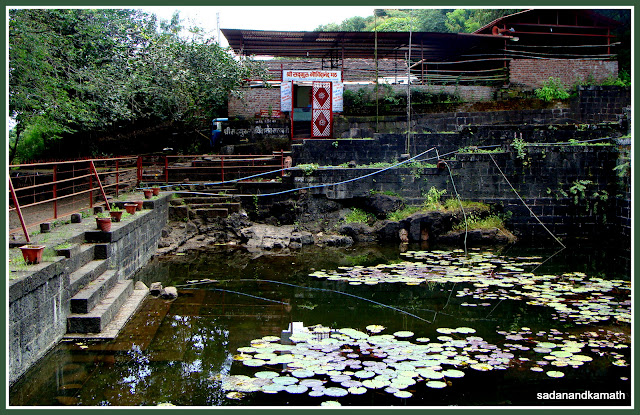 |
| Ancient pond in Pateshwar. At the far end is Sadguru Govindanand Maharaj Mutt |
 |
| Stairway to the main Shiva temple, Pateshwar |
After about half an hour, we walked past a square shaped pond partially covered with lotus flowers. Just opposite of the pond was Sadguru Govindanand Maharaj Mutt. But the main Shiva temple was nowhere to be seen. Then we noticed that an old man in saffron dhoti was going towards stairways right of the pond. We followed him and met him halfway. He seemed surprised to see us. He looked very old (may be in 80s) and his voice was very feeble to fully understand as to what he said. I guess his name was Giri. He was the priest of the main Shiva temple and he was on his way to conduct pujas. During my brief talk with him, he discouraged me from taking pictures saying that in that process, we may overlook the beauty of this place and also miss the intricately carved statues. I told him that I take pictures of beautiful places such as this one to enable me to revive my memories of such visits when I am not in a position to revisit such places due to old age. He did not respond to my answer which meant that he saw merit in this argument. We followed him and it was only after reaching the top of the stone stairways, we could see the main Shiva temple.
 |
| The main Shiva temple, Pateshwar |
 |
| Intricately carved Nandi of the main Shiva temple |
The moment I was in the court yard of the temple, I fell in love with this serene and peaceful place. The temple was surrounded by dense forest from all sides. I would not have imagined that we would be in solitude in a place which was just 14 kms from Satara city, 7 kms away from hustling bustling MIDC and just 4 kms away from Degaon village. I felt like spending the entire day of solitude to get a feel of the place. The temple was stated to be constructed some time in 16th century AD. The intricately carved Nandi facing the temple was housed in a Mandapam typical of Shiva temples. The main temple was in a slightly depleted condition but some of the stone carved statues adorning the inner walls of the temple as well as in two small temples in the court yard were in good condition.
 |
| The statue of Sheshashayee (Vishnu) adorniong the inner wall of the main Shiva temple |
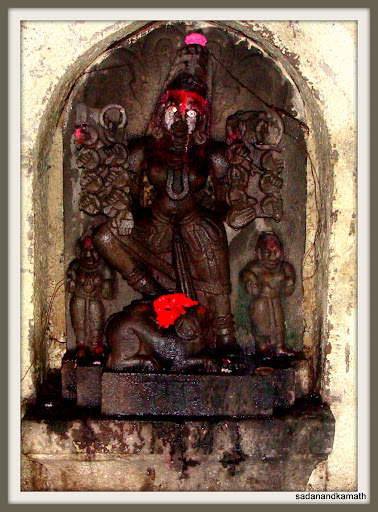 |
| The statue of Mahishshur Mardini in a small temple in the court yard of the main Shiva temple. |
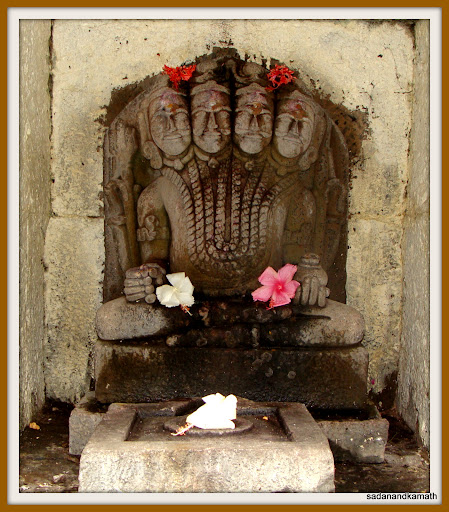 |
| The rare four headed Shiva statue in the court yard of the main Shiva temple |
After conducting abhisheks of the shivling inside the temple followed by the aarti, the priest left the temple not before guiding us for our visit the eastern side of a cluster of smaller cave like temples, about 200m from the main Shiva temple, which were supposed to contain one crore of shivlings of different sizes. As we were walking through a narrow slushy path covered with the overgrowth of tree branches, I saw a dark brownish snake of about 5 feet in length crossing the path just 3-4 feet from me. I guess it was Dhaman (rat snake). Later, our driver confirmed that the place was infested with Dhamans, the docile and harmless variety of snake. After a walk of about 100m, we came across 2 small temples housing shivlings of various sizes placed on platforms. Unfortunately, we could not enter these cave like temples as they were flooded with water. We had to satisfy ourselves by seeing these shivlings only from outside. I am sure that some snakes do reside in these cave like temples.
 |
| A platform with many thumb sized shivlings inside one of the cave like temples in Pateshwar |
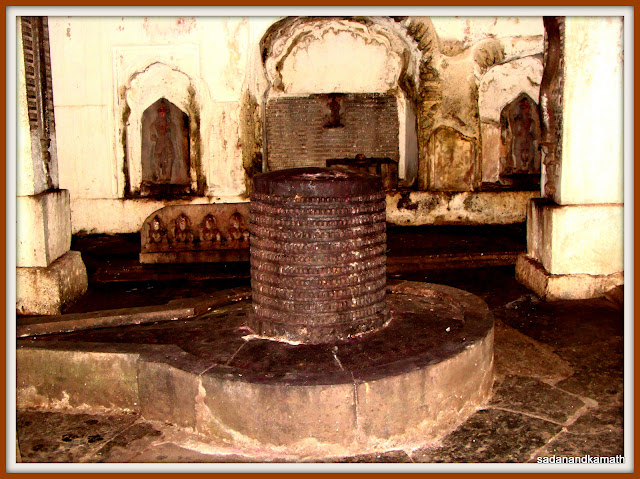 |
| A huge shivling decorated with numerous thumb size shivlings in one of the cave like temples |
 |
| A stone plaque with numerous thumb size shivlings inside one of the cave like temples. |
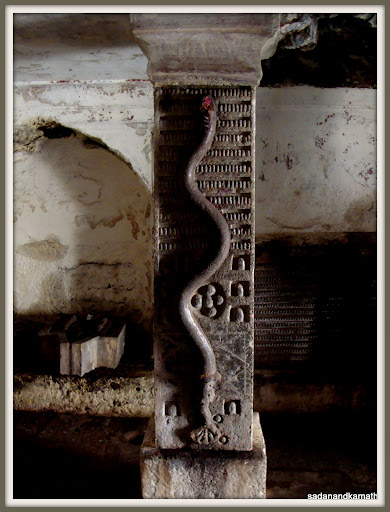 |
| One of the pillars in a cave like temple decorated with stone carved serpent and small shivlings |
After a walk of another 100m, we came across a relatively bigger temple located almost underground except for the entrance. This temple had also intricately carved Nandi facing the sanctorum housing thousands of shivlings of various shapes - from thumb size to as high as 5 feet tall. In one of the two smaller cave like temples, there was a large and tall shivling of the height of about 5 feet. The shivling was decorated with numerous small shivlings of not more than thumb size. We also saw some stone plaques placed on the cave walls fitted with numerous small shivlings. On our rough estimates, we must have seen at least around ten thousands of shivlings. Eariler, one of the inmate of the Mutt had told my wife that one bag of rice will not be sufficient to place a single rice on each of the shivlings in the cave like temples. While this may be an overstatement, the fact remains that there are so many shivlings in these temples that one can easily lost count of them. All these temples also housed some unidentified stone carved statues .My guess is that they may be of some sages.
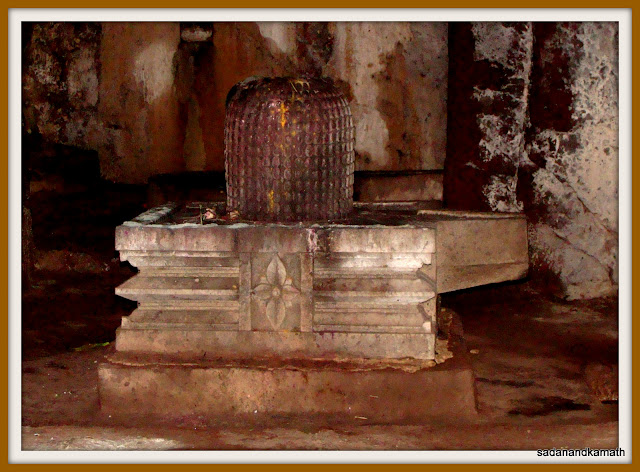 |
| A huge shivling decorated with thumb size shivlings in one of the cave like temples |
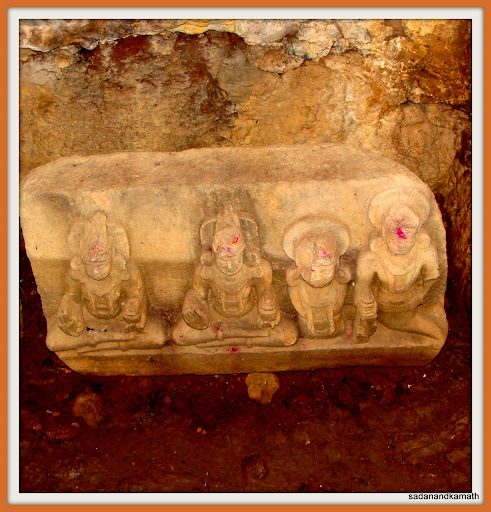 |
| A stone plaque with unidentified statues inside a cave like temple |
It was pitched dark inside all the cave like temples. At one of the temples, I almost fell in the mini pond located in one of the corners of the sanctorum. Luckily, I could balance and stand in the pond with knee deep water. The small pond roughly of the size of 2x2 feet collects water from the seepage of the cave walls. Probably, in olden days, the water from the pond was used for conducting daily abhisheks of shivlings. I suddenly remembered that I had torch in my pouch – a habit I have developed since my trekking days. But still the torch light was not sufficient to minutely observe the carvings. Another handicap was the absence of a knowledgeable guide. As of now, nothing is known as to who constructed these temples and about the artists who sculptured the Nandis, the statues and shivlings.
 |
| A shivling with trimurti kept outside a cave like temple. |
At the end of our trip, we felt most happy that we could visit such a awesome place by sacrificing our planned visit to Thosegar and Chalkewadi. These temples are archaeologically important but as of now there does not seem to be any caretaker for them. Fortunately, there is not much of vandalism here as very few people visit this place.
Our next and the last destination of the trip was Sajjangad but our driver suggested to spend some time at Kshetra Mahuli ( also called Mahuli Sangam), the confluence of Venna and Krishna rivers, which we agreed. The place is hardly 5 kms from Satara off to Satara-Pandarpur road. There are four main temples on the banks of Krishna river – two on each of the sides. On the west bank of the Krishna river are Kashi Vishweshwar temple and Sangameshwar temples and on the east side of the river are Someshwar and Rameshwar temple. This place is also called ‘Dakshin Kashi’ and all the religious ceremonies conducted at Varanasi are also conducted here. Unfortunately, due to less time at our disposal, we could see only 17th century constructed Kashi Vishweshar temple. Those interested in the temple architectures may require at least half a day to see all these temples and some smaller temples also. In fact, if we get a chance to visit Satara again, we would definitely spend more time here to see the temple architectures in detail.
 |
| Krishna river at Kshetra Mahuli with Rameshwar temple in the background. It was sad to observe that Krishna river was used as a dhobi ghat and the stairways leading to Rameshwar temple as drying place. |
 |
| Kashi Vishweshvar temple on the banks of Krishna river |
 |
| Sangameshwar temple on the banks of Venna river at Kshetra Mahuli |
After finishing lunch at Sayali Restaurant at Powai Naka, we commenced our last destination of this trip – Sajjangad. Since I had already seen it last year, I sat down near the Swami Ramdas Samarth Mutt and let my wife have the round of temples. Thereafter, we went to the famous table top located behind the temple complex. The views from the table top were great as usual. Compared to the last time when we had visited in the morning, this time the afternoon sun fell directly on the valley giving a great photo opportunity. One of the regular visitors to this place had told me that the valley remains green throughout the year because of the Urmodi dam water. After spending about an hour or so, we returned to our hotel not before buying some Kandi Pedhas from Latkar Sweets located near Powai Naka to take back home, the sweet memory of our trip to Satara.
 |
| Table top of Sajjangad |
 |
| Valley view from Sajjangad table top |
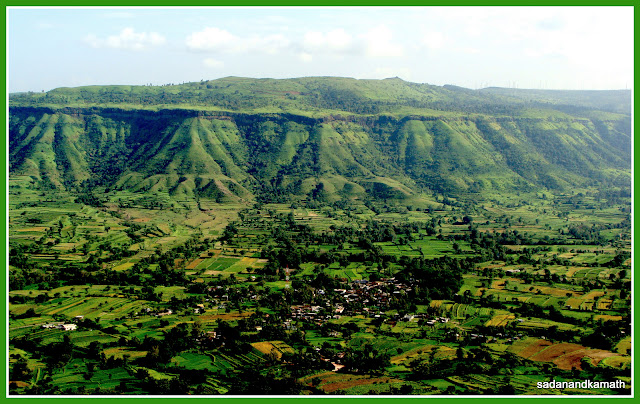 |
| Valley view from Sajjangad table top |
More Pateshwar pictures.